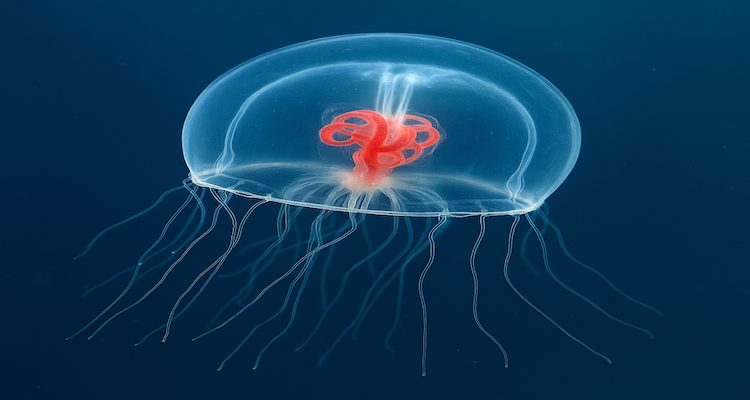The Immortal Jellyfish: Nature’s Eternal Time Traveler
Discover the Turritopsis dohrnii, a jellyfish capable of biological immortality. Learn how it defies aging, and what it means for science and humanity.
Introduction: The Creature That Rewinds Its Clock
Imagine if aging wasn’t inevitable. What if, instead of dying, your body could hit rewind—regenerating to its youthful state, again and again? In the depths of our oceans lives a small, transparent creature that’s rewriting the rules of life and death. Known as the “immortal jellyfish,” Turritopsis dohrnii has fascinated scientists and sparked philosophical debates across the globe. It may be small, but its power to escape death is anything but insignificant.
Context & Background: A Marvel in the Mediterranean
First discovered in the Mediterranean Sea in the late 19th century, Turritopsis dohrnii remained relatively obscure until the 1990s, when marine biologists observed an unprecedented trait: under certain conditions, the jellyfish could revert its adult cells back to a juvenile stage.
Native to warm tropical and temperate waters, this tiny hydrozoan—barely larger than a pinky nail—belongs to the class of animals known as cnidarians, which also includes sea anemones and corals. What sets it apart is not its appearance, but its radical regenerative abilities.
Main Developments: How Immortality Works
The key to the jellyfish’s so-called immortality lies in a process called transdifferentiation—a rare biological feat where a mature cell transforms into an entirely different type of cell. While humans can generate certain new cells (like blood or skin), we can’t convert a skin cell into a nerve cell. Turritopsis dohrnii, however, can.
When stressed—by injury, environmental changes, or starvation—it undergoes a biological reversion. Instead of dying, the jellyfish transforms back into a polyp, its earliest life stage, essentially restarting its lifecycle. This process can theoretically occur infinitely, making the jellyfish biologically immortal, though not invincible. It can still be eaten or die from disease.
In the wild, it’s unclear how often this reversal happens. But in lab settings, researchers have watched the cycle occur multiple times, revealing a biological escape hatch from aging.
Expert Insight: “A Window Into Human Longevity”
“The ability of this jellyfish to revert its cells to a primitive state is one of the most exciting discoveries in regenerative biology,” says Dr. Maria Pascual-Torner, a molecular biologist at the University of Oviedo, Spain. “It gives us a window into understanding the biological levers of aging and potentially even reversing it.”
In 2022, Dr. Pascual-Torner led a team that mapped the genome of Turritopsis dohrnii and compared it to its mortal cousin, Turritopsis rubra. Their research, published in Proceedings of the National Academy of Sciences, found key differences in DNA repair, stem cell renewal, and cellular maintenance genes. These are the building blocks of longevity—and possibly, a guidebook for future medical applications.
Public interest, too, has surged. The jellyfish has become a favorite topic in science documentaries and popular culture, often used as a metaphor for humanity’s obsession with eternal youth.
Impact & Implications: Beyond the Deep Sea
While true immortality in humans remains science fiction, the Turritopsis dohrnii’s capabilities offer inspiration for stem cell research, anti-aging therapies, and regenerative medicine. Scientists hope to translate the jellyfish’s tricks into breakthroughs for diseases like Alzheimer’s, spinal cord injuries, and even cancer.
Still, researchers caution against overhype. “We are at the beginning of understanding how this jellyfish achieves what it does,” says Dr. Shin Kubota of Kyoto University, one of the few scientists to cultivate the species in captivity. “It may take decades before any applications reach clinical relevance.”
Moreover, the jellyfish reminds us that nature’s most profound secrets often reside in the smallest, most unassuming organisms. Its resilience challenges us to rethink our relationship with aging—not as a fixed fate, but as a biological puzzle yet to be fully solved.
Conclusion: A Timeless Wonder in a Fragile World
The story of Turritopsis dohrnii is more than a scientific anomaly—it’s a humbling reminder of nature’s ingenuity. As we continue to explore the boundaries of life extension, this tiny jellyfish serves as both a muse and a mystery.
In a world obsessed with youth, perhaps the immortal jellyfish isn’t just a biological marvel—it’s a symbol of what’s possible when evolution bends time itself.
(Disclaimer: This article is for informational purposes only. While the biological phenomena described are based on peer-reviewed scientific research, medical applications for human longevity are still under development and not guaranteed. Always consult with qualified professionals before making health-related decisions.)
Also Read: Dolphin Uses Sea Sponges as Tools—And Teaches Her Young











